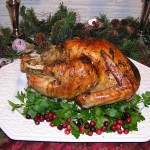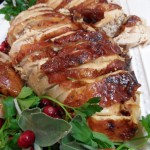Roasted Turkey
Ingredients
- Roasting a Turkey
- 1 tablespoon salt
- 2 teaspoons fresh ground pepper
- 1 stick of butter, room temperature
- 1 onion, peeled, cut in fourths
- 2 carrots, cut in half
- 2 sticks celery, cut in half
- 6 whole garlic cloves
- 4 cups chicken broth or water
- Remove the turkey and the bowl of stuffing from the refrigerator 30 minutes before you start to roast, and allow turkey to come to room temperature. This assures for even cooking. If you are using a frozen turkey, wash inside and outside of the turkey, and pat dry with paper towels. Make sure the bag of giblets has been removed (look in both cavities). If you have brined the turkey, it is best to let the turkey air dry on a cooling rack placed over a baking tray in the refrigerator overnight to dry the skin out so it will brown better.
- Preheat oven to 325 degrees, and place rack on lowest level.
- Choose a large, heavy weight-roasting pan with 2-inch sides that is large enough so the turkey does not touch the sides. Aluminum disposable pans are all right, but don’t have the strength of a metal pan. Place a baking tray under a disposable pan for safety. Teflon coated roasting racks placed at the bottom of the pan allow for more even browning and airflow but are not essential. Use a spray oil on the roasting rack to help prevent sticking.
- Cut 2 large pieces of cotton string to tie the turkey up. Get 8 metal skewers or toothpicks out. In a small bowl, add 1-tablespoon salt and 2 teaspoons of fresh ground black pepper.
- Place a large piece of plastic wrap on the counter and place the turkey on plastic.
- Salt and pepper the entire turkey both inside and out liberally.
- Don't over stuff the turkey. The stuffing will expand from the turkey juices as it cooks. Spoon stuffing lightly into the neck cavity, then fold the neck skin over the stuffing, tucking it under the bird or securing it to the back skin with a skewer or toothpicks. Fill the main cavity, and if you don't want the exposed stuffing to brown too much, cover it with foil. Put any extra stuffing into a buttered baking dish, cover and refrigerate it, then bake it toward the end of the turkey's roasting time.
- Use the string and tie the drumsticks together. Take a large piece of string, and starting under the turkey near the wings, loop around the turkey and tie the wings together.
- Put turkey in V-rack or roasting pan breast side up.
- Bring a stick of butter to room temperature (or place in microwave for 10 seconds). Use your hands, and rub the entire outside of the turkey with butter. Scatter the vegetables on the bottom of roasting pan and pour 2 cups of broth or enough liquid to cover the bottom of the pan. Wash hands extremely well with warm water and lots of soap. Use a large piece of foil, or fold 2 large pieces of foil together, and place loosely over turkey. Put turkey in the oven legs first.
- After an hour, baste every 30 minutes for a beautiful crispy skin. One hour before the turkey is cooked, remove the foil (save the foil for tenting and storing the turkey), and allow the turkey to brown. If one part of the bird is browning too quickly, rotate the pan. If it is getting too brown, put the foil back on to finish cooking. If the liquid is drying up too fast and the vegetables are looking like they are getting too brown, add some more chicken broth or water.
- I like to use a digital read probe thermometer. They are expensive, but it is a great investment. 30 minutes before the turkey is cooked, place the probe in the thickest part of the turkey thigh and close the oven door. Set the digital thermometer temperature for 165 degrees, or use an instant read thermometer to get an idea of the temperature of the turkey meat.
- When the alarm goes off, insert the probe into the opposite leg and check that it registers 165 degrees. Then place the probe in the center of the stuffing. It should read 160 degrees. The juices should run clear, not reddish pink when thigh is pierced. Continue cooking if the juices are not clear.
- Remove turkey from oven and place roasting pan on hot pads.
- Wad up several pieces of paper towel and make two “pot holders”. Carefully remove turkey from roasting pan and set on carving board.
- Remove stuffing to an ovenproof baking dish and cover with foil. Put in 200-degree oven until serving.
- Tent a large piece of foil over turkey and loosely cover. Let the turkey to rest for at least 20-30 minutes or more before carving. This makes sure you will have a moist and tender turkey.
- Make gravy (see recipe)



